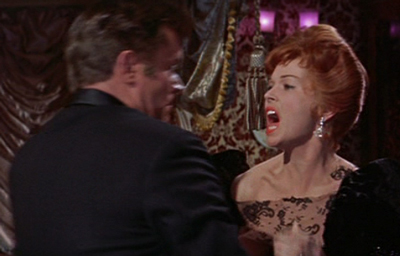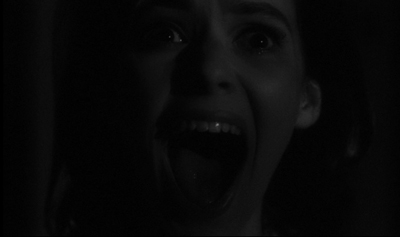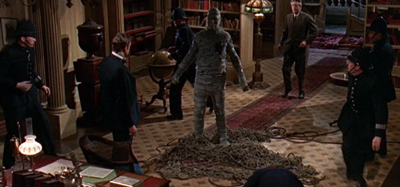| Release List | Reviews | Price Search | Shop | Newsletter | Forum | DVD Giveaways | Blu-Ray/ HD DVD | Advertise |
| Reviews & Columns |
|
Reviews DVD TV on DVD Blu-ray International DVDs Theatrical Reviews by Studio Video Games Features Collector Series DVDs Easter Egg Database Interviews DVD Talk TV DVD Talk Radio Feature Articles Columns Anime Talk DVD Savant HD Talk Horror DVDs Silent DVD
|
DVD Talk Forum |
|
|
| Resources |
|
DVD Price Search Customer Service #'s RCE Info Links |
|
Columns
|
 |
Icons Of Horror Collection: |

|
Icons Of Horror Collection: Hammer Films Sony Street Date October 14, 2008 / 24.96 Starring Christopher Lee, Peter Cushing, Barbara Shelley, Susan Strasberg, Paul Massie, Dawn Addams, Ann Todd, Ronald Lewis, Terence Morgan, Jeanne Roland, Fred Clark Directed by Terence Fisher, Seth Holt, Michael Carreras |
Sony once again opens its Columbia vaults for fans of the fantastic, this time highlighting four of its remaining horrors from the revered firm of Hammer Films, Ltd. The mix is a good one -- two monster romps, a crackling murder mystery and one genuine rarity uncut and uncensored. Icons Of Horror Collection: Hammer Films has titles starring Christopher Lee and Peter Cushing, and the screaming chores are ably handled by stars Dawn Addams, Barbara Shelley and Susan Strasberg. It's a fine Halloween horror sampler.
The Two Faces Of Dr. Jekyll
1960 / Color / 2:35 anamorphic widescreen / 88 min. 08 sec. / House of Fright

The good news first. Until now The Two Faces Of Dr. Jekyll has been almost impossible to see uncut, and Sony's version on disc appears to be full-length and uncensored at 88 minutes. The show was also known as House of Fright in an 80-minute abridged version distributed by American-International.
No, the title theme is not sung by Lou Christie, allthough I can imagine a heck of a good music video montage. This interesting Dr. Jeckyll experiment is certainly better than Hammer's other 'transformation' movie released on DVD earlier this year, The Man Who Could Cheat Death. The twisted screenplay by Wolf Mankowicz (Expresso Bongo, The Day the Earth Caught Fire) plays fast and loose with Robert Louis Stevenson's famous story. Mankowicz's bearded, dour Henry Jekyll (Paul Massie) is a lone researcher attempting to define and control the duality of man. He wants to liberate the potential of man's personality from the restraints of conscience and morality. Meanwhile, Jekyll's wife Kitty (Dawn Addams of The Thousand Eyes of Dr. Mabuse) is proving to be equally two-faced. She's having an affair with the wastrel gambler Paul Allen (Christopher Lee), on Henry's money.
Jekyll uses a potion to split his personality, all right, but the Hyde that emerges is a handsome and amoral cad eager for sensation. Hyde easily beds Maria (Norma Marla), a snake dancer at a bawdy night club-bordello. Hyde then fails to seduce his own wife Kitty (who doesn't recognize him). When he discovers that Kitty actually loves Paul, Henry/Hyde manages a strange series of machinations that inject tragedy into a structure more suitable for a farce. Paul has a fateful date with Maria's snake, while Hyde maneuvers Kitty and Maria into each other's bedrooms. As the song goes in The Band Wagon, everyone ends in mincemeat.
Aided greatly by the impressive music of David Heneker and Monty Norman, The Two Faces Of Dr. Jekyll gets off to a rousing start. Director Terence Fisher's pace sometimes slackens -- a fairly dull shot of Jekyll injecting his potion lingers in stasis seemingly forever, with the music working hard to keep our interest. The almost uniformly bright lighting enforces a rather artificial, theatrical atmosphere. Eric Boyd-Perkins' editing (Gorgo) enlivens several decorative dance scenes in the London fleshpots -- and adds a couple of jarringly inappropriate wipe transitions. Let's assume they were somebody else's idea.
Dawn Addams may well be dubbed but gives an effective performance as a woman leading a double life. In her own way Kitty is trying to accomplish the same identity split as her husband. For once given a character role with some meat on it, Christopher Lee proves that he can play a very convincing cad. Paul Massie is a gloomy Jekyll, and his Hyde always seems a twitch away from breaking into a crazed grin. Jekyll insists that his dual-man theories have nothing to do with good and evil, but Mr. Hyde's deeds are almost uniformly reprehensible. When Hyde's chemical transformations begin to get out of control, we don't sympathize with him. There's nobody to root for in this clutch of selfish people.
The Two Faces Of Dr. Jekyll is short of actual horror content. It's easy to see why the movie would need cutting for American release -- Hammer seems to be reaching for salacious sex to replace censor-forbidden sadism and violence. Some of the snake dancing by Norma Marla (or her double; she wears a mask) is pretty vulgar, including a shot of her plunging the head of a large boa constrictor into her mouth. The club harlots talk a bawdy streak, with the word "bitch" used prominently at least twice. And the film teases us with some near-nudity in the Hyde-Maria seduction scene. Columbia pawned the film off on A.I.P., but it must have proven fairly inappropriate kiddie matinee material, even when cut.
The picture gives us a nice bit from Oliver Reed as an irate pimp (!) and a too-brief couple of moments with the talented child actress Janina Faye (Horror of Dracula). When the plot requires a London detective we're not surprised to see stalwart Francis De Wolff enter the scene. David Kossoff (The Mouse that Roared) is Henry's moralizing friend, who realizes that the Coroner's facile conclusion that Henry Jekyll "ventured too far into God's domain" explains exactly nothing.
Scream of Fear
1961 / B&W / 1:66 anamorphic widescreen / 81 min. 20 sec. / Taste of Fear

Scream of Fear is one of the best psychological thrillers immediately post- Psycho, a consistently entertaining mystery with a likeable lead performance from Susan Strasberg. Wheelchair-bound Penny Appleby (Strasberg) returns to her home after years at school. Her school companion has drowned herself, and Penny's father has just died. The cliff-side Appleby estate is now being run by stepmother Jane (Ann Todd), who assures Penny that she'll always have a home. But the schoolgirl's unstable nerves are getting the better of her -- she keeps seeing her father's body turning up in odd places, like the storeroom behind the pool. Family chauffeur Bob (Ronald Lewis) tries to console Penny, while Doctor Pierre Gerrard (Christopher Lee) comes almost every night for dinner and to keep Jane company. Gerrard suggests repeatedly that Penny may have a stress-related nervous disorder, making the girl feel even more unstable.
The success of this project led screenwriter Jimmy Sangster to write more blood-soaked murder mysteries for Hammer, some with similar family settings and others relying on shaggy gimmicks. Scream of Fear (originally titled Taste of Fear in the U.K.) is a contemporary story given fine direction by Seth Holt, a former editor and producer who would make only four more movies before his death in 1971. In a completely convincing interior / exterior set of the Appleby manor house, Holt and his cameraman Douglas Slocombe create an excellent mystery atmosphere. Penny rolls her wheelchair cautiously to and fro, ever aware of her vulnerability. Bob the chauffeur risks his job to give Penny some comfort, and we suspect that the stepmother Ann is jealous. And what Dr. Gerrard has in mind is anybody's guess. Penny and Bob join forces to find some piece of evidence proving that Ann killed Penny's father, but it looks like someone has discovered their plan.
Ann Todd and Ronald Lewis play excellent support to Ms. Strasberg, who has one of those faces that commands both sympathy and attention. Penny shows inner strength as the pressure mounts. In a normal thriller we'd wait for the handsome boyfriend or lover to arrive and save the day, but the fact that it's a Hammer film leaves Penny's fate in serious doubt. What we remember most is Penny's relationship to water -- the Swiss lake, the murky, Diabolique-like swimming pond, the crashing waves that seem so mysterious behind Slocombe's misty lens diffusion.
It's best that viewers watch carefully from the beginning. Scream of Fear packs a number of satisfying surprises.
The Curse Of The Mummy's Tomb
1964 / Color / 2:35 anamorphic widescreen / 80 min. 07 sec.

Prolific Hammer producer Michael Carreras directed The Curse Of The Mummy's Tomb, an acceptable entry in Hammer's Mummy series. The Carlo Martelli music score is interrupted during flashback scenes by Franz Reizenstein's superior cues for the 1959 Terence Fisher version, reminding us that it was all done much better before. Carreras' camera placement is weak and he has a fondness for ragged pans across décor and faces, something that doesn't work out too well in the Techniscope format.
The script only half-develops its ideas. When a curse befalls the raiders of the tomb of Prince Ra-Antef, we know that scurvy Egyptologist Hashmi is behind it; he's played by Hammer's all-purpose eastern fanatic George Pastell (The Mummy, The Stranglers of Bombay). Fred Clark is fine as Alexander King, a Barnum-like impresario hoping to make millions by exhibiting the Mummy back in England. His subplot is terminated before it can really get up to speed. King is meant to provide cultural contrast as a vulgar American stirring up trouble, but he's easily the most honest person in the show. Everyone else seems to be hiding their identities or their feelings.
The potentially interesting material involves a love triangle. Egyptologist John Bray (Ronald Howard) watches while his intended Annette Dubois (Jeanne Roland) falls in love with a more interesting new acquaintance, Adam Beauchamp (top billed Terence Morgan). The smooth fiancée poacher Adam is a man with a secret; it seems that he knows altogether too much about Egyptian relics to be the amateur he claims he is.
The Curse Of The Mummy's Tomb starts with a graphic hand-chopping but pulls back on the gore thereafter; what we get are ten minutes of repetitious Mummy attacks modeled on Terence Fisher's original. Ra-Antef smashes through doors and lurches into fancy houses, but he lacks Christopher Lee's panache. He also seems physically unimpressive; he doesn't tower over his victims as did Lee. The Mummy costume looks like a baggy stack of wet newspapers, with a head that resembles the comic character Zippy covered in ashes. Ra-Antef's mask allows for no variation in expression.
But the show moves quickly and has great color and lighting by cinematographer Otto Heller. Ms. Roland is stunning in her gowns, including the number she picks for a midnight jaunt through the sewer, carried by the Mummy. It's interesting that Hammer's male leads at this time all seemed to be in their 40s ... almost as if the young Turks in the front office wanted to avoid the romantic competition that younger actors would pose.
The Gorgon
1964 / Color / 1:66 anamorphic widescreen / 83 min. 17 sec.

The Gorgon is one of Terence Fisher's more interesting horrors, a film about a female monster pursued not by a strong Van Helsing-type character but by men weakened by their interest in women. Paul Heitz (Richard Pasco) wants to discover what killed his brother and father, but the authority figures in the tiny town of Vandorf seem intent on hiding the source of a series of unsolved murders. Asylum doctor Namaroff (Peter Cushing) submits false death certificates to hide the fact that all of the victims have been literally turned to stone, or "gorgonized." Paul sends for his professor friend Karl Meister (Christopher Lee) to help solve the mystery.
In the script provided by John Gilling, the male characters live in various states of fear. Dr. Namaroff is particularly ineffective in controlling women, even a madwoman in his asylum. Nursing assistant Carla Hoffman (favorite Hammer horror queen Barbara Shelley) is repulsed by Namaroff's jealousy when she becomes attracted to Paul. Paul and the Doctor end up fighting each other instead of watching out for the dreaded Gorgon Magaera, who claims her victims on the second night of each full moon.
Fisher directs this outing with considerable skill, maintaining tension in a story with very little action. James Bernard's eerie Gorgon theme puts new chills into the familiar Hammer castle sets. Barbara Shelley's Carla is a sympathetic heroine to Richard Pasco's sincere hero, but Christopher Lee's professor is the only real take-charge character. Interestingly, this horror piece has no comedic coachmen or gravediggers, making it distinctly more sober than most other Hammer Gothics.
What probably stunted The Gorgon at the box office was its lack of a good monster. The tall Magaera is shown too much and is little more than a scowling woman with greasepaint makeup and rubber snakes in her hair. We're told that a complicated Roy Ashton makeup concept was thrown out in favor of a quick fix by the effects department. The movie was obviously done on a tiny budget -- how Hammer continually made costume pictures so cheaply is quite a mystery -- and the makeup and special effects they were willing to pay for just weren't up to the job. But as a drama The Gorgon works very well. Screenwriter John Gilling would move on to direct a pair of similarly low-budget, impressive Hammers, The Reptile and Plague of the Zombies.
The four features in the Icons Of Horror Collection: Hammer Films are fine transfers given expert attention. All of the films, including the half-frame Techniscope titles, are from new elements made directly from the original negatives. The Gorgon has rich colors that associate it with the earlier Hammer output originally printed in Technicolor. It and Scream of Fear are also matted and pillar-boxed, masking away acres of dead space above and below the desired 1:66 compositions.
Sony provides no added commentaries or featurette extras but each film is accompanied by an original trailer. The strident trailer for Curse of the Mummy's Tomb makes fun of the picture, while the tense, graphic-based coming attraction teaser for Scream of Fear generates maximum interest by showing almost nothing but Susan Strasberg's screaming face. For 1961, it's a very progressive ad.
On a scale of Excellent, Good, Fair, and Poor,
Icons Of Horror Collection: Hammer Films rates:
Movie: The Two Faces Of Dr. Jekyll: Very Good; Scream of Fear: Excellent; The Curse Of The Mummy's Tomb: Very Good; The Gorgon: Excellent
Video: Excellent
Sound: Excellent
Supplements: trailers
Packaging: 2 discs in Keep case
Reviewed: September 17, 2008
Reviews on the Savant main site have additional credits information and are more likely to be updated and annotated with reader input and graphics.
Review Staff | About DVD Talk | Newsletter Subscribe | Join DVD Talk Forum
Copyright © MH Sub I, LLC dba Internet Brands. | Privacy Policy
Subscribe to DVDTalk's Newsletters
|
| Release List | Reviews | Price Search | Shop | SUBSCRIBE | Forum | DVD Giveaways | Blu-Ray/ HD DVD | Advertise |





